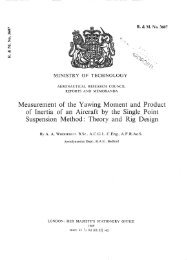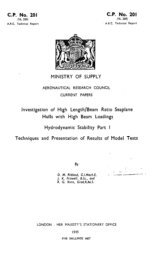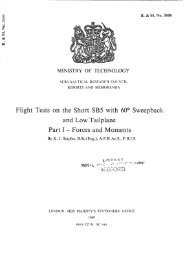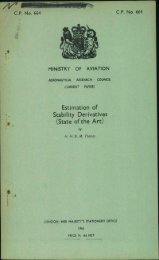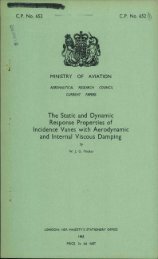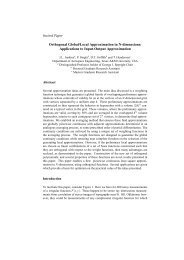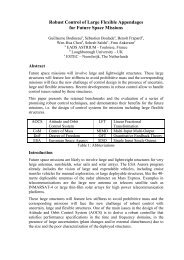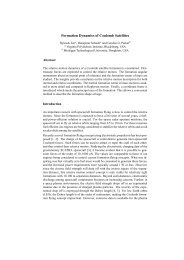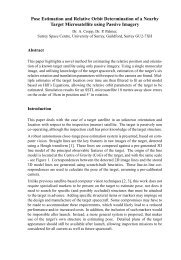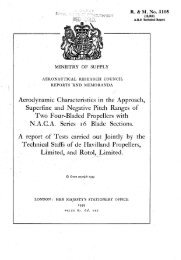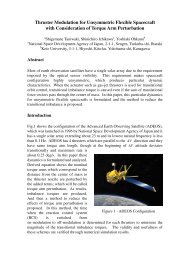The Aerodynamic Characteristics of Flaps
The Aerodynamic Characteristics of Flaps
The Aerodynamic Characteristics of Flaps
You also want an ePaper? Increase the reach of your titles
YUMPU automatically turns print PDFs into web optimized ePapers that Google loves.
position then the corresponding change in twist near zero iift is given approximately by<br />
C'<br />
-- ~: .<br />
A CL/<br />
. .<br />
c'<br />
. . . . . . . . . . . . . (33)<br />
C a 6 C<br />
where c' is the effective chord.<br />
On the basis <strong>of</strong> these assumptions Dent and Curtis have calculated the increment A C,,0 for<br />
flaps <strong>of</strong> various spans and at various chordwise positions on wings <strong>of</strong> various taper ratios. <strong>The</strong>ir<br />
final formula for A C~0 takes the form<br />
d0<br />
AC,,o = ff2AC,,, +- ~ A,~:l-'ff~ . . . . . . . . . . . . (34)<br />
where A C~, is the full-span pitching moment increment as defined in section 3.3 on an unswept<br />
wing,<br />
ff 2 is the conversion factor for part-span flaps, already discussed in sections 3.5.2.2<br />
and 4.3.2, and shown in Fig. 14,<br />
do is the two-dimensional lift-curve slope <strong>of</strong> the mean wing section,<br />
/1 = tan 7 (y = angle <strong>of</strong> sweep-back),<br />
ft, function <strong>of</strong> wing taper ratio, flap span and flap ehordwise position, shown in Figs.<br />
27a, b, c.<br />
<strong>The</strong> first term on the right-hand side <strong>of</strong> equation (40) represents the contribution due to the<br />
local change <strong>of</strong> C,,o on each spanwise dement <strong>of</strong> the flapped part <strong>of</strong> the wing, the second term<br />
represents the contribution due to the change in spanwise loading at zero lift caused by the flap.<br />
For an unswept wing the latter term is zero.<br />
From equation (38) we can write<br />
+ aoA d CL:F#3 . . . . . . . . . . (35)<br />
A C~o = ff 2A C,., 2a. " "<br />
and using the ordinary lifting-line theory for elliptic loading, we have<br />
Hence, we can write<br />
d0 1<br />
2a6 1"5<br />
AC,.o = ff2dc,,, + ~.5 r~,Ac.~: . . . . . . . . . . . . (36)<br />
From sections 4, '5, A Cz: is given by<br />
=<br />
where 2,ic:/c) is given ill Fig. 5, and Z 2(/~) is given in Fig. 6 for split and plain flaps and Fig. 7<br />
for slotted flaps.<br />
For flaps in the normal trailing edge position (see, for example, section 4.3)<br />
-- A C,~, = ff ~A CL:,<br />
where ff~ is given in Fig. 13 for split and plain flaps ; for slotted flaps see section 5.3.<br />
For flaps not at the trailing edge we must calculate A CL': (see equation (16), section 4.1.1) and<br />
hence A C,,', and finally apply equation (12) <strong>of</strong> section 3.5.2.1 to determine A C~,.*<br />
Dent and Curtis 132 have compared the results <strong>of</strong> their formula with some experimental results,<br />
and they conclude that the formula provides an acceptable guide to the magnitude <strong>of</strong> the<br />
pitching moment change at zero lift for preliminary design purposes. A further comparison<br />
has since been made for a number <strong>of</strong> other experimental results, and it is concluded that the<br />
* Dent and Curtis gave curves for A C~, and ~:, deduced from split-flap data on NACA 230 sections, for use with<br />
equation (40) ; the above procedure is, however, more in line with previous sections <strong>of</strong> this report and is more general.<br />
25



